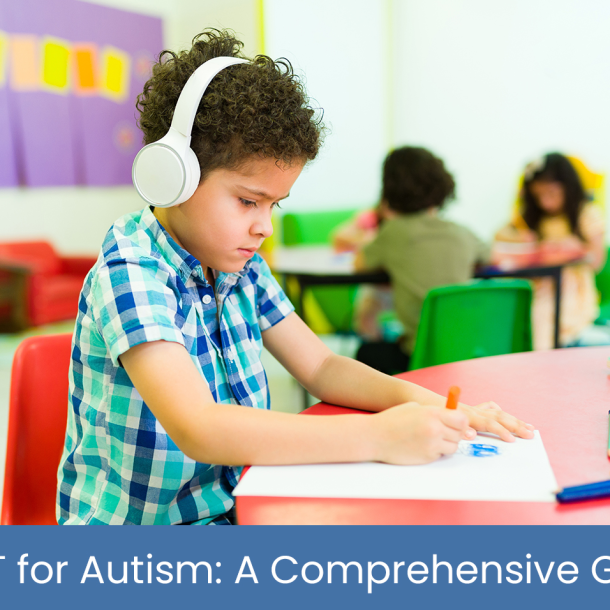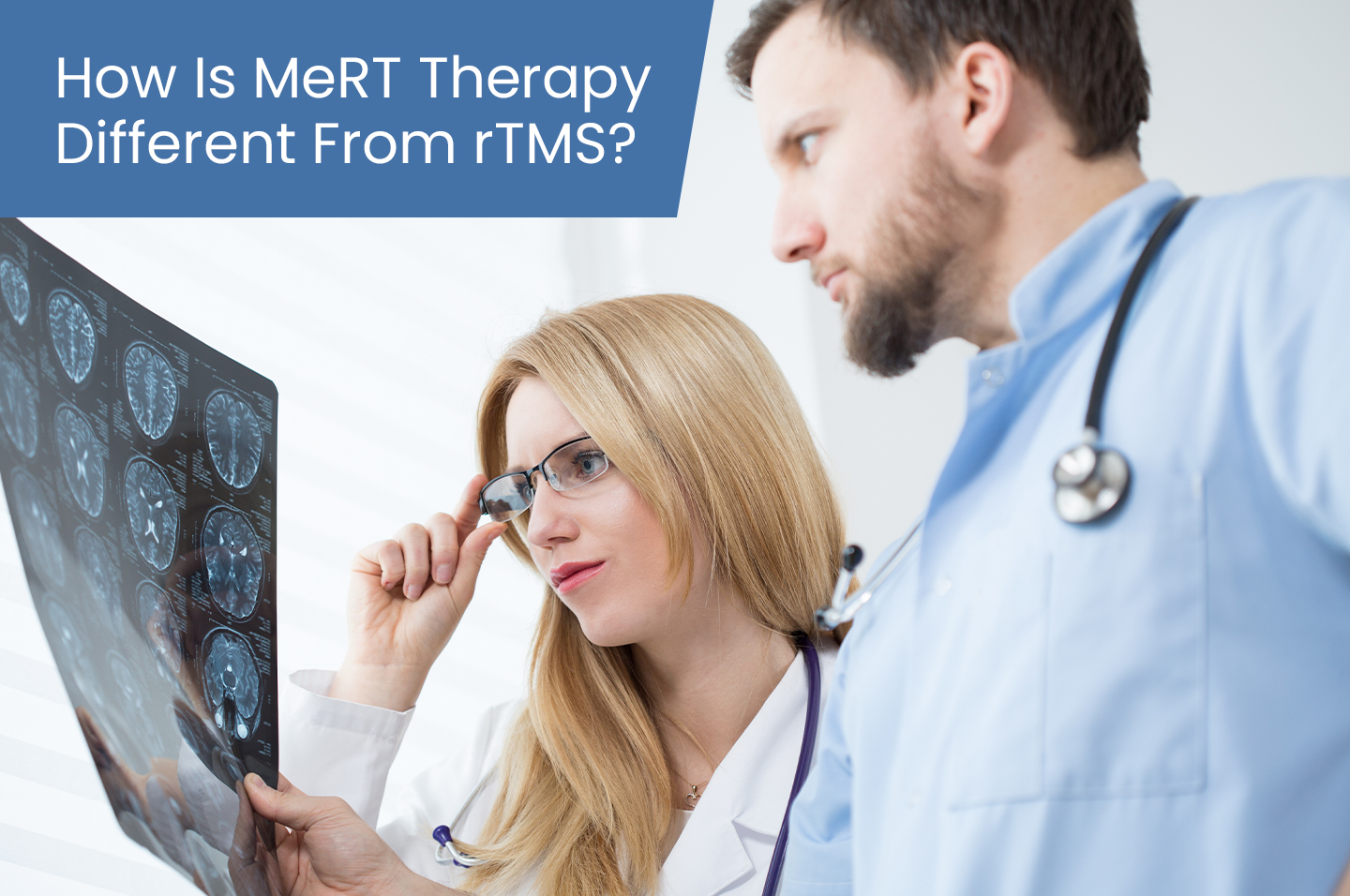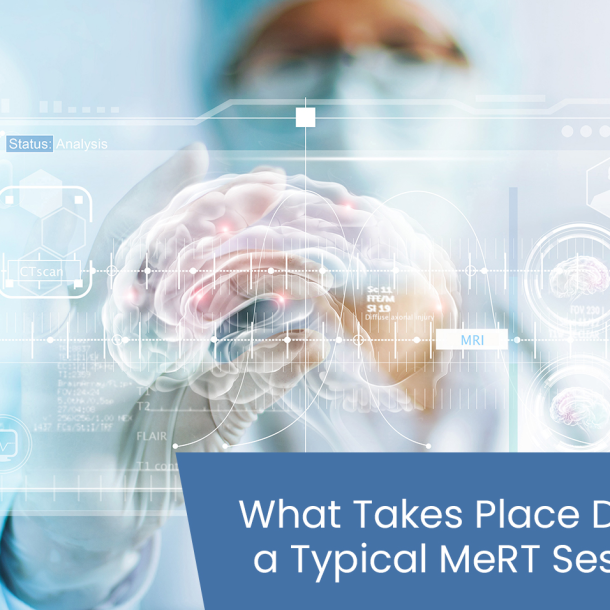
How Is MeRT Therapy Different From rTMS?
- Home /
- How Is MeRT Therapy Different From rTMS?

Magnetic eResonance Therapy (MeRT) and repetitive Transcranial Magnetic Stimulation (rTMS) share certain functions, yet they are profoundly different in several ways.
To determine the differences between the two therapies, we must first dissect what each treatment does and its advantages and disadvantages. Then, we must contrast them against each other.
By providing a comprehensive comparison, we can empower you with the knowledge to make informed decisions about your mental health therapy. This in-depth analysis instills trust and reliability, permitting you to navigate treatment options confidently.
What is repetitive Transcranial Magnetic Stimulation (rTMS)?
MeRT and rTMS are indeed closely linked, as MeRT uses components of rTMS to treat mental health conditions. While both therapies sound similar, there are subtle, noteworthy differences.
Repetitive TMS focuses on stimulating underactive brain cells using focused magnetic fields. It aims to allow brain cells to perform more efficiently, thus reducing and alleviating symptoms.
What is it used to treat?
Repetitive TMS provides a treatment option when mental health issues are not fully responsive to conventional treatments like therapy or medication. Therapists recommend rTMS for:
- Burnout
- Anxiety
- Depression
- Attention-deficit hyperactivity disorder (ADHD)
- Post-traumatic stress disorder (PTSD)
- Migraines
- Obsessive-compulsive disorders (OCD)
Ongoing research is looking at other potential uses, including treatment for smoking and epilepsy.
How does it work?
Once clients receive an assessment, they experience five minutes of treatment sessions. Sessions involve Theta Burst Stimulation (TBS), which administers three quick treatments over 15-minute appointments. Professionals administer the treatments Monday through Friday over a ten-working-day interval.
Clients are comfortably seated and alert for the entire treatment duration. To treat issues like depression, a magnetic coil suspends over the region responsible for depression and mood control. Repetitive TMS targets these areas because they hope to stimulate brain areas that decrease during depression.
Individuals experience several clicking noises followed by pauses as the magnet turns off and on. This off-and-on sensation is from a gentle, pulsating energy applied to the brain region to stimulate activity.
After the treatment, clients can successfully resume their daily activities.
Is it safe?
Health Canada approved rTMS in 2005, and the Food and Drug Administration approved it in 2015. Overall, rTMS is deemed safe because it is non-invasive, doesn’t need anesthesia, and does not cause seizures.
Yet, there is evidence of some mild to moderate side effects. The side effects improve after a session and decrease with subsequent sessions. They include:
- Headache
- Scalp pain or discomfort
- Lightheadedness
- Spasms, tingling, or facial twitches
If the side effects are bothersome, your healthcare professionals can adjust the stimulation level. Reducing the stimulation level should reduce any symptoms.
Additionally, professionals may advise taking over-the-counter pain medication before treatment. Repetitive TMS can trigger headaches in those experiencing frequent migraines or headaches. Therefore, they may need to stop treatment.
Some uncommon side effects include:
- Emotional highs (mania) in those diagnosed as bipolar
- Seizures
- Hearing loss (if ears don’t receive proper protection during treatment)
The long-term effects of rTMS are unknown, thus prompting additional research.
Results
If the treatment works, you may experience elimination or reduction of symptoms. Relief may occur after several weeks. The effectiveness of rTMS improves as more techniques are understood, the best areas to receive stimulation are identified, and the number of stimulation sessions required.
What is Magnetic eResonance Therapy (MeRT)?
MeRT adopts an individualized treatment option for patients. It tailors location and treatment frequency based on quantitative Electroencephalogram (qEEG) and Electrocardiogram (EKG) results.
Experts use EKG and qEEG results to determine deviations in brain function compared to baseline results. This allows them to pinpoint areas requiring stimulation to alleviate symptoms.
MeRT combines rTMS, EKGs, and qEEGs to tailor treatment to the client’s brain activity. Experts analyze EKG and qEEG results to detect brain function and activity, and determine neural synchronization. This allows experts to tailor treatment to individuals by facilitating healthy brain communication between neurons.
What mental health disorders does it treat?
MeRT shows success in improving symptoms for those with:
- Autism
- Traumatic brain injury/concussions
- Post-traumatic stress disorder (PTSD)
- Anxiety
- Depression
- Sleep disorders
How does this treatment work?
Magnetic pulses travel to the targeted brain areas. Most appointments consist of 30 treatments lasting six seconds. Between sessions, there is a 54-second rest. Each session lasts for 45 minutes. MeRT aims to reshape the client’s brainwave activity independent of the initial cause.
Are there side effects?
MeRT is another safe, noninvasive procedure. The side effects are mild, with the most common being tension headaches at the stimulation site. These headaches last for one to two hours and respond to nonprescription drugs.
Other side effects include:
- Increased agitation
- Hyperactivity
- Euphoria
- Seizure (rare)
Results
The treatment response differs. Clients generally experience positive effects during their assessment week. The treatment duration depends on the response rate. A clinician determines the length of treatment after reviewing qEEG and clinical differences. It is recommended that patients undergo one month of therapy after the assessment.
While the results vary, the longer the treatment, the longer the patient experiences changes.
How do these therapies differ?
Standard rTMS therapy simulates one area of the brain using fixed frequencies. Unlike MeRT, it is not explicitly tailored to the individual. While MeRT uses rTMS, it utilizes quantitative evidence from qEEGs and EKGs to determine which brain areas are affected.
MeRT provides a tailored solution to symptom reduction, whereas rTMS uses a standardized protocol to treat mental health.
Other than the procedure and depth of analysis, the two therapies are remarkably similar. One doesn’t boast better results than the other. However, experts require additional research into the effects of long-term treatment.
Visit Neurosync Brain Treatment Centre to Discuss Treatment Options
Only a healthcare provider can ascertain the best course of action for you regarding magnetic resonance therapy and repetitive transcranial stimulation. The Neurosync Brain Treatment Centre experts can review your medical history and treatment response to determine whether you are a candidate for these treatments.
Many clients benefit from MeRT and rTMS treatments in alleviating the symptoms associated with mental health issues when traditional methods prove ineffective. Furthermore, there are remarkable results from this form of therapy.
To book an appointment, call us at 365-799-8438, email us at neurosyncbtc@outlook.com, or complete our online form.
Working Hours
Email: neurosyncbtc@outlook.com
Woodbridge. ON. L4L 1A6

